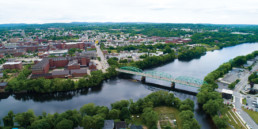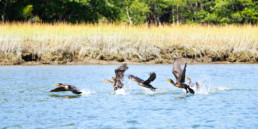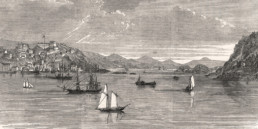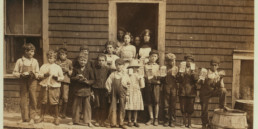Is Maine Still Hurricane-Proof?
By NANCY GRIFFIN
The role weather plays in Maine life is as important as the sun rising–and far more likely to be talked about. On the coast, and especially on islands where life revolves around boats and ferries, knowing the weather in advance and preparing for it is vital. Often, it’s a matter of survival.
But preparations can prove inadequate. High winds, pounding rain and excessively high tides can knock out power lines, smash boats, wash buildings out to sea or fill them with water. When storms include snow and ice, the damage can last longer if power lines go down all over the state.
In the Atlantic region, hurricanes are one of the most destructive weather forces. New Orleans is still recovering from the utter devastation of 2005’s Katrina, one of the country’s deadliest hurricanes ever, while being battered by other, more recent destructive storms, and the New York-New Jersey area is still rebuilding after Superstorm Sandy.
Giving Storms The Cold Shoulder
Maine is luckier than most Atlantic states when it comes to hurricanes, as they generally run out of power by the time they reach us. The reason hurricanes rarely hit the coast, explained John Jensenius, warning coordination meteorologist with the National Weather Service in Gray, is the low temperature of Maine’s ocean water.
“The storm’s energy comes from warm waters, and 85 degrees Fahrenheit is not a Maine water temperature,” Jensenius said. “Once it hits cooler water, it doesn’t have the energy to maintain hurricane strength.”
Nor’easters and blizzards are Maine’s primary destructive storms. The state is more likely to get the winds, some flooding and rain as the aftermath rather than the brunt of the hurricanes themselves. Which does not mean Maine never gets hurricanes.
“In an average year we have zero hurricanes,” said Jensenius, but one might hit on average every 30 years. Most recently, Hurricane Bob was a close call in 1991, but was downgraded to a tropical storm. Still, Bob managed to kill three people in Maine. Gloria hit southern Maine in 1985, Donna in 1960, Edna and Carol in 1954.
Hurricanes may be rare, but the memories of them stick. Ted Turner, 67, of Swan’s Island, remembers the stories about the deadly hurricane of 1938, alternately known as the Great New England Hurricane and the Long Island Express. This hurricane, which killed 682 from Maine to Long Island, was only the third to hit New England since a deadly hurricane in 1635. Property damage in 1938 was estimated at $306 million, or $4.7 billion in today’s dollars.
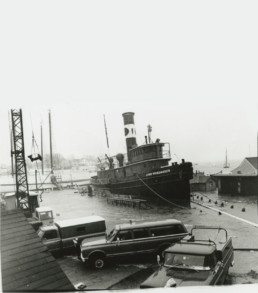
“I heard stories that it knocked down a lot of our old hotel,” said Turner, who is known on the island as an amateur historian.
Local memories are stronger of the back-to-back hurricanes of 1954–Carol and Edna, coming 11 days apart. The damage totaled in millions of dollars, and destroyed much of that year’s apple harvest.
Carol’s wind and rain began, Turner reported, “But then the sun came out and it was flat calm.” Unfortunately, this was by no means the end of it. “That was when the eye of the storm went over us. That’s when it’s calm,” he remembered.
In that calm, Turner recounted, a fellow from the island went down to the fishing wharf to check his boat. That’s when the storm came back with a vengeance out of the northwest. “He had to hide,” Turner said. “At the wharf, the wind picked up a building and destroyed it.”
George Young was just 25 at the time, lobstering from his own boat out of a family camp on Little Garden Island, one of the White Islands off Vinalhaven. “I’d like to forget that mess,” he said of Hurricane Carol.
“Salt water and seaweed were coming in all over the camp. It blew part of the afternoon and then all night long. We thought we would lose the camp. We got quite scared. It was terrible wind. I was ready to go out the back and go into the woods,” said Young. “We were lucky to keep the boats. Mine stayed on its mooring, but I lost my skiff.”
When morning broke, dead lobsters littered the shore. A Vinalhaven resident found Young’s skiff ashore in a harbor there and returned it. He got in his skiff, got to his boat and went home to Rockland. “I was glad to get home,” he said.
The name Carol was retired for all time for hurricanes after this storm.
Snow Hurricanes
Under certain conditions, when tropical air from a hurricane’s remnants pass over colder air, a “snow” or “white” hurricane can occur. One such occurrence, the Blizzard of 1888–also called the Great White Hurricane–caused destruction from Maine to the Chesapeake Bay area.
Maine more frequently experiences nor’easter storms that usually batter the coast between October and April, when cold winds blow in from the northeast, hit the warm, moist waters of the Gulf Stream, and produce copious amounts of rain or snow. Their high winds sometimes reach hurricane force, which can create super high tides and coastal flooding.
Hurricanes and the tropical storms that may turn into hurricanes are named. Some winter storms were named in the recent past, but the government now frowns on naming them “because a winter storm’s impact can vary from one location to another, and storms can weaken and redevelop, making it difficult to define where one ends and another begins,” said a National Weather Service spokesperson.
When private weather services took to naming winter storms, mostly for TV purposes, the language quickly escalated, giving us “Snowmageddon” and “Snowzilla.” Perhaps the National Oceanic and Atmospheric Administration (NOAA) and the National Weather Service figured there was nowhere to go from there. Especially since the so-called Storm of the Century had occurred in 1993.
What’s in a name? A 1991 storm was first dubbed The No-Name Storm and the Halloween Gale, but was really a nor’easter that absorbed Hurricane Grace offshore, then changed course, weakened then strengthened again over warm southern waters, turned into a tropical storm, headed northeast and became a hurricane. A record-high 100.7-foot wave was recorded by a buoy off Nova Scotia.
Later, because of the rare combination of systems and conditions, it became known as The Perfect Storm. It killed 13 people from Florida to Canada, including the six-man crew of a Gloucester, Massachusetts sword-fishing boat, Andrea Gail.
Their plight was recorded in a book by Sebastian Junger and a movie.
That storm damaged at least 100 homes in Maine, including the summer home of the Bush family at Walker Point in Kennebunkport.
“All of a sudden, it came back out of the northwest and it was worse than before …”
The East Coast sees an average of 40 nor’easters a year, often spanning hundreds, and sometimes thousands, of miles. Many nor’easters that batter the coast never acquire names or reach actual hurricane status, but still manage to inflict plenty of damage. A nor’easter in the late 1970s hurled boats ashore in the Midcoast, flooding Camden’s public landing and filling harborside businesses with water.
A nor’easter that struck just before Valentine’s Day 2017 dumped up to 40 inches of snow in some parts of Maine and caused record snowfalls in other parts of New England. Climate researchers called it a once-in-a-lifetime event.
A 1976 nor’easter drove a surge of water up the Penobscot River to Bangor, flooded that city’s downtown area, put the Kenduskeag Plaza underwater, and floated cars away.
“A Japanese ship awaiting a load of french fries had to wait a couple of weeks to get floated off a sandbar” after that storm, remembered Jensenius.
Some climate scientists say the warming of ocean waters may produce more frequent storms or storms of greater intensity in coming years, but likely not hurricanes, at least not in Maine.
“It’s rare to see a hurricane make landfall on the coast— we see it more often in the Gulf of Maine,” said Jensenius. Even though ocean water temperatures are warming, he added, Maine waters won’t be warming to 85 degrees anytime soon.


